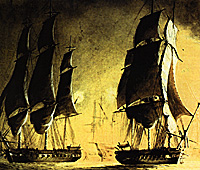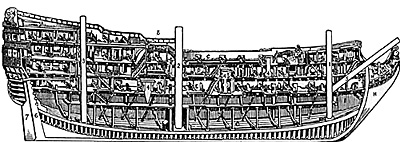One of the most prominent features of naval campaigning in the French Revolutionary and Napoleonic era was that pitched battles were very much the exception rather than the rule.
However much a Nelson might fret and fume at the apparent lack of urgency displayed by the high command, not even he could always guarantee to intercept an enemy fleet at sea. Naval operations were conducted in a much more difficult and resistant medium to that of operations on
land, and the result was a dramatically smaller number of major battles.
Even when whole fleets were destroyed or captured, it would not necessarily be as the
result of a battle at sea. At Toulon and the Texel (twice) fleets had changed hands
without any sort of combat between ships - and the only 'combat' in the first of the two
Texel cases was between warships at anchor and horsed cavalry crossing the ice.
Genuine Fleet Actions
Then again the major naval battles, when they did take place, might turn out to be
rather stodgy and static affairs, distinctly lacking in such features as manoeuvre, fast
action, or the cut and thrust of deception and surprise. The Nile, Copenhagen and Algeciras all fell into this category, insofar as one of the two fleets was anchored into a defensive position, and the action inevitably became a matter merely of 'hard pounding.'
This leaves us with barely half a dozen examples of genuine fleet actions fought at
sea during this era. There's Trafalgar, of course, and the complex evolutions (often
unjustly ignored) of the Glorious First of June. There's St Vincent and there's
Camperdown. There's Trafalgar, Trafalgar and, er, that's just about it. Oh yes, and
there's Cape Noli.
What follows is my attempt to design such a game called, for want of a better title, 'Noli
Illegitimos.' Please note that although the general picture is collect I have simplified some features (eg supply) and invented some of the details (eg ships' names) - due to a lamentable lack of research in depth on my part.
Strategic Map Game
'Noli Illegitimos' is essentially a strategic map game fought between two sides of one
to three players each, communicating secretly with an umpire, which can be extended to last for up to a weekend of intensive play. However it can also be compressed into an evening if the
participants are ready to cut a few corners. It can also incorporate actions between model ships on a traditional wargame table (without needing an umpire in these phases). In our test run at the Wellingborough 'WHELK' wargame club there were in fact two tactical actions, ending with the total destruction of the French fleet but the equally total British loss
of Corsica.
It is 1st March 1795. The Royal Navy is blockading the Toulon naval base, having
been evicted from it a year ago by the success of the French siege. Vice Admiral
Hotham has 3 x 3-deck battleships (100 guns), 12 x 2-deck battleships (74 guns)
and 7 x 1-deck frigates [For convenience this strength is expressed as '3-12-7'].
His main base is at Gibraltar, 900 miles from Toulon; but his main anchorage is at
San Fiorenzo (North Corsica) and he draws some of his supplies from there and from
Bastia (also in Corsica - note that this island has just been annexed by King
George upon the urging of the ex-Republican Paoli). Hotham also gets supplies from
Genoa, Leghorn and Naples in Italy, and even from the East coast of Spain (Spain
has an enormous fleet under Langara, at Cartagena, but seems unwilling to actually
go to sea. 0-2-2 Neapolitan ships have been promised for Hotham's fleet from Naples, which is a more reliable source of reinforcement). Apart from Spain and all the Italian states, Britain is also allied to the Austrians, who have a large army in North Italy, but no fleet.
On the French side Lieutenant General (ie Vice Admiral) Martin's strength in Toulon is
5-10-9. He has 18,000 men (Gen Gentili) ready to invade Corsica, which has only just
been seized from France. The Armee de Italie (Scherer) is defending the line of the
Alps while the Armee des Pyrelees (Pelignon) is currently attempting to evict Spanish forces from the French town of Pelpignan.
The prevailing wind in this area is from the Northwest in winter, Southwest in summer,
but it is very changeable and the storms can be treacherous at any time of year,
especially close to the (numerous) coastal mountain ranges.
At the start of the game you should tell the umpire what you have chosen for the locations and orders of all the British warships. Your main aim is to defend Corsica and maintain the blockade of Toulon. Note that Paoli is now creating all sorts of trouble on land in Corsica, and our Governor General, Elliott, has called for marines to help defend key posts (note you
have 30 marines per deck of ship - eg a 3-decker has 90 marines). Your secondary aim is to give every help to the Austrian (General Devins) and Piedmontese (Prince of Coligan) armies operating along the coastal Corniche road between Genoa and Nice (Front 2 line at Loano). Apart from
that, you should protect trade and co-operate with allied governments in Genoa, Spain, Rome and Naples. Note, however, that the island of Elba is potentially a useful base for us - although it is currently owned by Tuscany (with whom we are neither at war nor in a military alliance).
Your two subordinate rear admirals are Nelson, just back from losing an eye at Calvi) and Mann. General O'Hara is governor of Gibraltar. Note that at present you have just about enough naval stores to keep going, but the wear and tear of the weather uses up so much that even at full stretch your supply arrangements cannot do more than replace losses. One third of your supply in normal times comes from Corsica and two thirds from Gibraltar (allowing one convoy
arriving every two months), but in the case of heavy battle losses it would all have to
come from Gibraltar.
The French ships sail better and faster than ours, and they notoriously carry more men
and guns, weight for weight.
At the start of the game you should tell the umpire what orders you are giving to all your
ships (which all start in Toulon). Your aim is to re-conquer Corsica, which will need all of
Gentili's 18,000 troops, not only because of the British and Austrian armies, but also
because the traitor Paoli has organised the population against France. However, it is
imperative to defeat the British fleet before daring to launch our transports onto the
sea. The weather makes the passage of the troops hazardous enough without the certain destruction that would attend them if the British ships got among them.
Our two subordinate Chefs d'Escadre (rear admirals) are Canteaume and Richery. They
are competent and experienced, which is more than can be said of either the officers
or the crews of your ships. At present all crews are also short of one third of their
numbers, and only untrained soldiers (from Gentili's force) are available to complete
the numbers. As for naval stores, there are none left at al. If you lose a spar, therefore,
you cannot replace it. Note also that the Royal Navy is reputed t be able to fire three broadsides to every two of ours.
As a secondary aim, you should also co-operate with the French armies at Perpagnan and in the Alps. Scherer is especially in need of supplies along the horrible coast road to his front line near Cape Noli, where he faces the enemy entrenched in Loano. It would help him if you could run in supplies by sea - and equally stop the enemy receiving his supplies by sea.
More Noli
This article appears in MagWeb (Magazine Web) on the Internet World Wide Web. If we take the examples of two of the most significant sea campaigns - the French attack on Ireland in 1796 and Bruix' cruise in 1799 - we can see the point rather clearly. In the first case the bulk of the invasion army was allowed to sail much of the way up Bantry Bay before the British fleet had even left Portsmouth; in the second case Bruix was able to sail a
considerable fleet from Brest to Toulon and Genoa, and then back again via Cartagena,
without once being brought to battle.
If we take the examples of two of the most significant sea campaigns - the French attack on Ireland in 1796 and Bruix' cruise in 1799 - we can see the point rather clearly. In the first case the bulk of the invasion army was allowed to sail much of the way up Bantry Bay before the British fleet had even left Portsmouth; in the second case Bruix was able to sail a
considerable fleet from Brest to Toulon and Genoa, and then back again via Cartagena,
without once being brought to battle.
 'Cape Noli?' you may snort 'Never heard of it.' Well don't worry too much if you
haven't, since it was an indecisive action fought out on 13-14th March 1795 by
somewhat minor admirals - neither Hotham nor Martin were exactly household names, even in their own day - both of whom lost two ships out of fifteen and then reverted to very much the same postures as they had been in before the fight. However, it is worth noting that if matters had turned out only slightly differently the two fleets might have missed each other entirely - with
potentially serious strategic consequences - or then again there might have been a decisive bloodbath with one or the other fleet completely destroyed or taken. All this means that there is plenty of scope for a wargame, since there were so many 'what ifs' at Noli that almost any outcome might have resulted.
'Cape Noli?' you may snort 'Never heard of it.' Well don't worry too much if you
haven't, since it was an indecisive action fought out on 13-14th March 1795 by
somewhat minor admirals - neither Hotham nor Martin were exactly household names, even in their own day - both of whom lost two ships out of fifteen and then reverted to very much the same postures as they had been in before the fight. However, it is worth noting that if matters had turned out only slightly differently the two fleets might have missed each other entirely - with
potentially serious strategic consequences - or then again there might have been a decisive bloodbath with one or the other fleet completely destroyed or taken. All this means that there is plenty of scope for a wargame, since there were so many 'what ifs' at Noli that almost any outcome might have resulted.
GENERAL SCENARIO
DETAILED BRITISH SCENARIO
DETAILED FRENCH SCENARIO
Noli Rules
British Updates
French Updates
Map (Western Section) Large file: 129K
Map (Eastern Section) Large file: 129K
Back to Battlefields Vol. 1 Issue 5 Table of Contents
© Copyright 1996 by Partizan Press.
Other military history articles and gaming articles are available at http://www.magweb.com